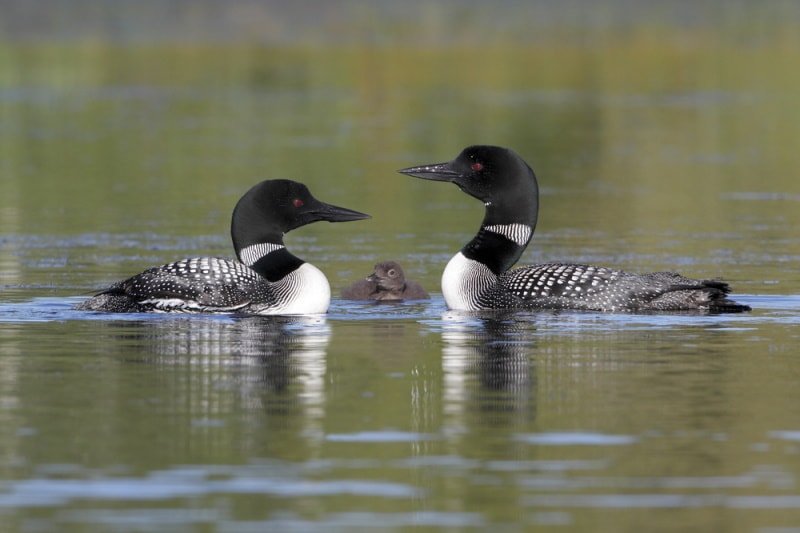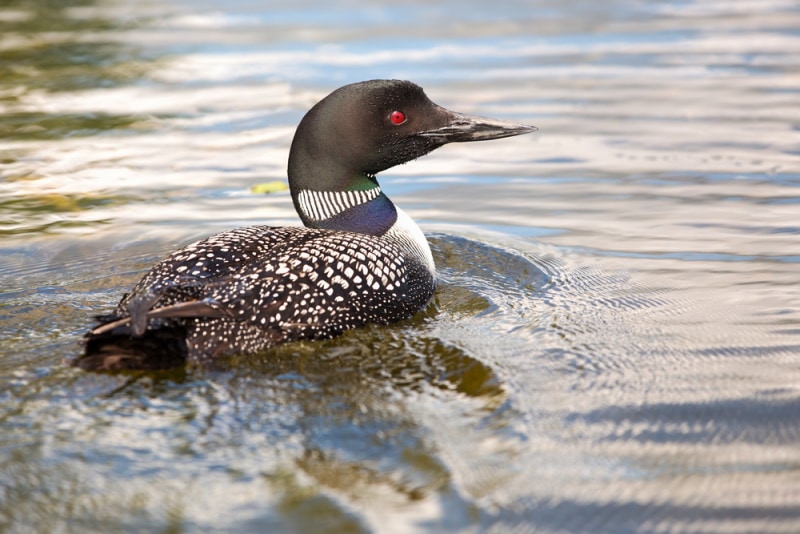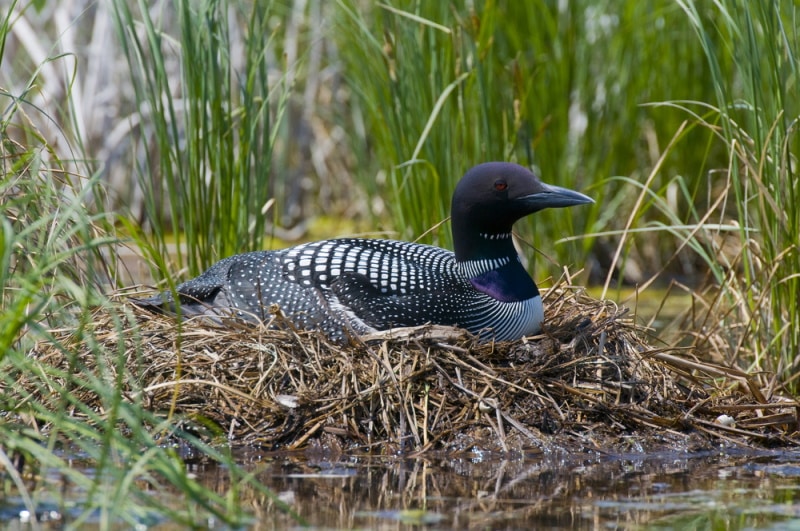Common Loon: Field Guide, Pictures, Habitat & Info
Last Updated on

Few species capture the essence of the North Woods better than the Common Loon. Its distinctive calls and yodels are quintessential sounds that are unmistakable. While it looks like a duck, it is part of a different family of birds called Gaviidae. There are only five species in this group globally, of which all live in the eastern part of North America.1
The Common Loon lives in several northern states, with its range extending into Canada and Alaska. Minnesota declared it its state bird in 1961.2 Canada also pays homage to the species with its image on the country’s $1 coin, affectionately called the loonie.3

Quick Facts about the Common Loon
| Habitat | Marine coastal waters, large forested lakes |
| Diet | Primarily fish with the occasional insect or crustacean |
| Behavior | Active mainly at dawn and dusk |
| Nesting | Monogamous with one clutch of eggs per year |
| Conservation | Species of least concern |
| Scientific name | Gavia immer |
| Lifespan: | 15–30 years |
Common Loon General Description
The Common Loon is a relatively large bird, getting up to 35 inches long and weighing over 13 pounds. Its wingspan is nearly 60 inches wide. Males are considerably larger than females, weighing an average of 26.6% more. However, the sexes are similar in color, a typical trait in monogamous species. It’s worth noting that the color of its winter plumage is different than during the summer.
The Common Loon has a long black bill and head with piercing red eyes. It has a vertically striped black and white collar around its neck and a checkered back. Its chest is white. During the winter, the black morphs into a dark brown with no markings. Its chest remains white.

Common Loon: Range, Habitat, Behavior, Diet & Nesting
The Common Loon has endeared itself to birdwatchers and others alike. It’s easy to identify and doesn’t look like other species you may see. The closest in appearance is the Yellow-billed Loon, which is rarely seen south of the tree line in Canada and other arctic regions.
Range
The range of the Common Loon spans Canada’s entire length into the northern states of America. It also lives on the coasts of Iceland and Greenland, across the pond to the western shores of Europe. It is a migratory bird, making chance sightings possible. It spends its winter in the southeastern portion of the United States and along the west coast.
Habitat
Loons prefer forested lakes and rivers, particularly in places with little human disturbance. Unlike animals like raccoons and deer, these birds will avoid areas with plenty of activity and shoreline housing. You’re most likely to find them in large lakes over 60 acres with submerged logs. Research has also shown they have greater reproductive success in places where there is limited or no public access.
Behavior
Loons usually live in pairs or with their young during the breeding season. The male and female will defend their territory, relying on vocalizations and visual displays to ward off intruders. They group up during the winter and will forage with other birds. Loons are awkward on land because of the location of their feet, which makes walking difficult.
Loons are most at home in the water as surface divers. They can go down up to 200 feet underwater. They often forage near submerged logs, where they’re more likely to find their prey.

Diet
Live fish are their primary food source, which loons will take from anywhere along the water column. Their sharp bills and keen eyesight allow them to hunt almost effortlessly in the water. They’re more likely to forage near shorelines during the breeding season when they have young. Loons will eat their prey underwater. They also will take crabs or crayfish occasionally.
Nesting
Some of the only times you’ll spot a loon on land is during mating and nesting after reaching sexual maturity at 2–3 years. The birds will breed in early spring, often just after ice out in some places. Both sexes will build the nest and incubate one to three eggs. Loons only have one clutch annually. The pair will defend their nest and territory with their characteristic yodeling call.
Incubation lasts about 28 days. The young are born semi-precocial, meaning they can get around like other waterfowl but still depend on their parents. They stay with them until they are 2–3 months old.
How to Find Common Loons: Birdwatching Tips
While the Common Loon is appropriately named, that doesn’t necessarily mean they’re easy to find. Your best bet is to go to riparian woods near a large lake or stream. These birds are flighty and will dive underwater if they spot you. That makes looking for them from the shoreline with a spotting scope a better way to see them.

What to Listen For
The Common Loon has several unique vocalizations that are unmistakable. It makes many sounds, including wails, hoots, and tremolo calls. You’re most likely to hear them at night. We can say for certain that hearing a bird on the water call at night is a magical experience you’re not likely to forget.
What to Look For
We suggest scanning a lake with a pair of binoculars first. Loons sit lower in the water than ducks or geese. You’ll probably spot the bird’s black head first. They will only swim in pairs during the summer. Be sure to look for their babies riding on their parent’s backs. It’s a memorable sight to see.
When to Look
Loons will actively feed at dusk and dawn. That’s when you’re most likely to hear or see them. Like many species, they often rest during the middle of the day when people and watercraft are present.
Attracting Common Loons to Your Backyard: Tips & Tricks
Unless you live on a North Woods lake, you probably won’t attract loons to your backyard. As we’ve discussed, these birds are primarily water-dwelling and only come onto land to nest. You’ll rarely see them anywhere else.

Common Loon Conservation: Is this Bird Threatened?
The Common Loon has two things going for it: it lives primarily in sparsely populated areas, and it’s long-lived. Its global population is currently estimated at 640,000 individuals. However, shoreline development, with the inevitable increase of human-habituated animals like raccoons, threatens local populations.
Scientists believe the number of European loons may decrease by up to 49% because of climate change and subsequent habitat loss. Interestingly, the North American population is stable, with moderate impacts expected.

Final Thoughts
The Common Loon is synonymous with the North Woods. Perhaps it likes the peace and quiet of these places as much as we do. Even if you’re not an avid birdwatcher, it’s still worthwhile to try to spot this bird and enjoy its unique calls. We promise you it’ll be worth the effort. And we’re sure you’ll understand why Minnesotans decided to honor this master diver.
Featured Image Credit: Brian Lasenby, Shutterstock
About the Author Chris Dinesen Rogers
Chris has been writing since 2009 on a variety of topics. Her motto with all of her writing is “science-based writing nurtured by education and critical thinking.” Chris specializes in science topics and has a special love for health and environmental topics, and animals of all shapes and sizes.
Related Articles:
10 Types of Hummingbirds in Arkansas (With Pictures)
8 Types of Hummingbirds in Nebraska (With Pictures)
5 Types of Hummingbirds in Idaho (With Pictures)
3 Types of Hummingbirds in Mississippi (With Pictures)
8 Types of Hummingbirds in Kansas (With Pictures)
5 Types of Hummingbirds in West Virginia (With Pictures)
5 Types of Hummingbirds in Ohio (With Pictures)
Where Do Nuthatches Nest? Nuthatch Nesting Habits Explained
